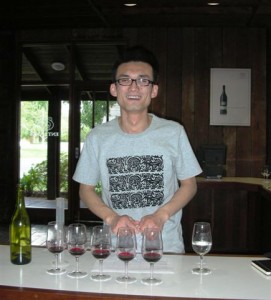
By Jim Boyce
–
Leo Liu has been interested in wine since he worked in a Dublin wine bar as a student. He is now operations manager for the restaurant Sureno, in Beijing boutique hotel Opposite House, and I talked to him about the wine selection there, his take on the Chinese palate, his recent three-week winery tour of Australia, and more.
–
How did you get involved in the wine business?
When I was studying in Ireland, I worked for Ely Wine Bar, one of the top wine bars in Dublin. I became interested in wine because they did a lot of staff training.
When I returned to China, I joined [wine importer and distributor] Palette Vino and seriously began my wine journey. I tried many wines, went to tastings, and started the WSET (Wine and Spirits Education Trust) course. About 18 months ago, I had the chance to join Sureno as operations manager, and here I am.
What kind of wines do you think most Chinese prefer?
In general, I think the Chinese palate prefers red wines with round tannins, a soft body, and a slight sweetness. The focus on red wine is due to the influence of French and, in turn, Chinese wine-making practices. Many people equate “wine†with “redâ€, so white wine gets much less attention. Many Chinese, including me and my friends, do not tend to like very dry or oaky wines.
But it is hard to generalize. There are Chinese who have the financial power to try many wines and drink fine Bordeaux and Burgundy, which means their palates are now different from the average Chinese, who hasn’t tasted that many wines and particularly not imported wines.
You recently spent three weeks touring Australian wineries. How did that come about?
The Australian Wine and Brandy Corporation had a scholarship program for people taking WSET courses. I took the course with Dragon Phoenix, passed with distinction, and applied for the scholarship. As part of the application, I had to write an essay on the topic “wines from somewhere rather than everywhere†and picked the Australian wine Grosset Polish Hills Riesling as my focus. I was picked along with candidates from Shanghai and Seoul.
The visit covered about 30 wineries in western Australia, southern Australia, Victoria and Tasmania, including Glaetzer, Yering Station, Wolf Blass, and Madfish. We did winery tours, tastings, and lunches and dinners with wine makers and winery staff.
What surprised you about the Australian wine industry?
One thing is the diversity of wine styles. We often think of Australian wine as a big Barossa Shiraz, but there are many styles of Pinot Noir, Cabernet, and other wines, from “hot†ones to cool-climate ones. I also found Australia’s wine regions to be diverse. For example, the Margaret River area has a cool climate and produces more elegant and peppery Shiraz, while the Barossa Valley makes rich and powerful ones.
Of the individual wineries, I was most impressed with Domaine A in Tasmania. Many people say it is too far south to get ripe grapes for good red wines, but they are doing it in a fantastic European style. We were lucky enough to try a 1998 Pinot Noir, which I would describe as an old world style wine made in the new world.
Wolf Blass was also impressive in terms of production skill. They have everything from boutique to mass produced wines. In Australia, it is possible to make both affordable daily drinking wines and world-class wines.
What is your experience with Chinese wines?
I haven’t liked the majority of Chinese wines I have tried. A lot of producers use imported bulk wine from Australia, Chile, or other places, and put it under a Chinese label. I don’t think they should be classified as Chinese wines. But there are other producers who are serious and show improvement. For example, we have wines from Grace Vineyard on our list.
What else do you have on the list?
We have about 300 wines – a blend of old world and new world. The prices range from about RMB230 for Bodegas Nekeas Viura from Spain to RMB30000 for Petrus from France.
Where do you see the wine market heading?
I think it will continue to grow but it will be tough. There are more distributors going after the same cake. The problem is that the cake is not getting much bigger, so the slices are getting smaller.
–
More posts by Jim Boyce
Sign up for the Grape Wall newsletter here. Follow Grape Wall on LinkedIn, Instagram, Facebook and Twitter. And see my sibling sites World Marselan Day, World Baijiu Day and Beijing Boyce. Grape Wall has no advertisers, so if you find the content useful, please help cover the costs via PayPal, WeChat or Alipay. Contact Grape Wall via grapewallofchina (at) gmail.com.

Leave a Reply
You must be logged in to post a comment.